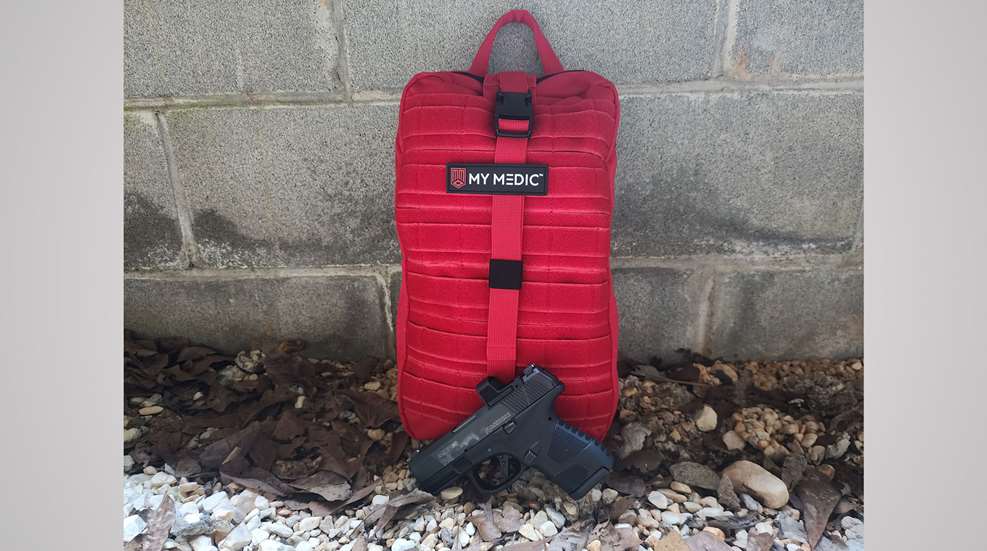
The shooting sports are exceedingly safe, because we work very hard to keep them so by following gun safety rules. That said, stuff happens, and injuries at the gun range are not unheard of. You should keep at least a small first-aid kit in your range bag in case it’s ever needed. It’s also important to note that many ranges are remote, and first and foremost, do as much as you can to make sure you have a method of communication that works out in the middle of nowhere in case an emergency springs up. If you don’t have cell coverage, at least let someone know where you’ll be and when to expect you back.
What should be in your first-aid kit? You want to be able to address the four most common needs you could see at the range.
Items for Handling Medical Events
This isn’t specific to the range, but any number of medical events can occur while you’re there, from minor annoyances like bug bites and allergy attacks to emergencies like heart attacks and low blood sugar episodes for diabetics. For this reason, I like to have baby aspirin (for potential heart attacks), hard candy (for low blood sugar), Benadryl cream and oral medication, saline eye wash, ibuprofen, blister pads, an instant cold pack, a cooling towel and the like in my kit. These will keep you shooting comfortably through the minor annoyances and can potentially help you or someone else survive long enough for paramedics to arrive in the case of a major problem. Of course, if you are allergic to bee stings or anything else that requires an epi-pen, be sure it goes to the range with you.
Items for Handling Smallish Scrapes and Cuts
Slide bites, scope bites, tiny shrapnel cuts (especially when shooting steel plates) and other small cuts and scrapes are bound to happen at some point. You can keep on shooting, but because ranges aren’t the cleanest environments, you want to clean and cover a minor wound before you get back to the fun. Carry some Band-Aids in various sizes including some butterflies, antibiotic ointment, isopropyl alcohol in liquid and wipe form, and a tweezers for splinters and tiny shrapnel (do not attempt to remove larger shrapnel that might be plugging a bleed; that’s an emergency to be handled at the hospital).
Items for Treating Minor Burns
Brass burns, powder burns, and grabbing-a-hot-barrel-without-thinking burns happen. They’re usually pretty minor, so a little burn gel and access to cool (not cold) running water, followed by a Band-Aid, will cover everything in this category that doesn’t require a trip to the hospital.
Items for Treating Gunshot Wounds
This is the big one. Obviously, any type of gunshot wound is an emergency, but there are a few things you can do while you wait for paramedics to arrive that might save a life. First, make sure the situation is safe before you charge in to help, and secure any firearms—you don’t want a wounded shooter to still be clutching his loaded gun while he’s in pain and doubled over. Point at someone specific and instruct them to call 9-1-1, or do it yourself if no one else is around. Then grab your kit.
It is very important that if you’re going to carry the following items, you must know how to use them properly. Seek out some emergency first-aid training or otherwise educate yourself to give anyone you must treat—including yourself if necessary—the best chance at surviving until professional medical care arrives.
In this part of your kit, three main items can safe a life: a tourniquet for wounds to extremities/arterial bleeds (I prefer the SOF Tactical tourniquet; the less hook-and-loop, the better), a chest seal to keep air out of a torso wound, and packing gauze to put pressure on other bleeds that might or might not require or might not be suitable for a tourniquet. Hemostatic gauze is much preferred, because it includes a clotting agent.
Other good-to-have items in this category include nitrile gloves, medical tape, trauma shears, a CPR shield, and elastic bandage tape to secure the gauze as a pressure dressing if you get the bleeding stopped. An Israeli bandage or other trauma pressure dressing is not a bad idea, but well-packed gauze and elastic bandage can accomplish the same purpose and are very versatile.
Again, you must know how to use these things, or they’re next to worthless. It doesn’t take much to learn how to pack a wound and keep pressure on it or to apply a tourniquet properly; you just need some simple instruction, and a little practice (on a training dummy) helps a great deal. I’ve taken the Stop the Bleed course offered by 5 Stone USA, and it was in-depth enough to teach me and let me practice the use of tourniquets and packing gauze, but not so intense that I couldn’t absorb or remember all the information. I recommend their training courses if there’s one scheduled near you, or check out the Red Cross’s Stop the Bleed course that’s a little less firearms-oriented.














































